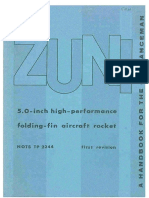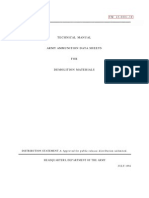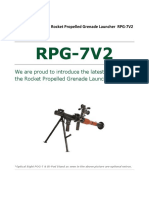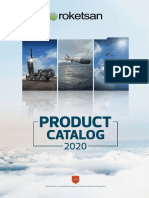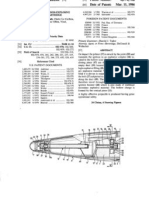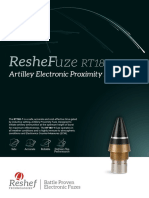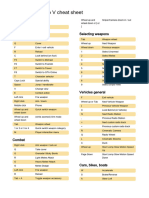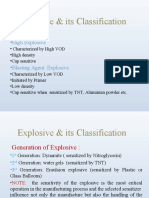0 ratings0% found this document useful (0 votes)
264 viewsLM2000AVM
LM2000AVM
Uploaded by
weter441) Antivehicle mines equipped with anti-handling devices can function like antipersonnel mines by exploding from unintentional acts, threatening civilians.
2) Many reports show that antivehicle mines endanger civilians in mine-affected countries by blocking infrastructure, farmland, and food deliveries. They claim many victims due to their large explosive size.
3) There are concerns that a significant number of existing antivehicle mines may violate the Ottawa Treaty and Amended Protocol II of the Convention on Certain Conventional Weapons due to their sensitive fuzes and ability to detonate from unintentional acts.
Copyright:
© All Rights Reserved
Available Formats
Download as PDF, TXT or read online from Scribd
LM2000AVM
LM2000AVM
Uploaded by
weter440 ratings0% found this document useful (0 votes)
264 views18 pages1) Antivehicle mines equipped with anti-handling devices can function like antipersonnel mines by exploding from unintentional acts, threatening civilians.
2) Many reports show that antivehicle mines endanger civilians in mine-affected countries by blocking infrastructure, farmland, and food deliveries. They claim many victims due to their large explosive size.
3) There are concerns that a significant number of existing antivehicle mines may violate the Ottawa Treaty and Amended Protocol II of the Convention on Certain Conventional Weapons due to their sensitive fuzes and ability to detonate from unintentional acts.
Copyright
© © All Rights Reserved
Available Formats
PDF, TXT or read online from Scribd
Share this document
Did you find this document useful?
Is this content inappropriate?
1) Antivehicle mines equipped with anti-handling devices can function like antipersonnel mines by exploding from unintentional acts, threatening civilians.
2) Many reports show that antivehicle mines endanger civilians in mine-affected countries by blocking infrastructure, farmland, and food deliveries. They claim many victims due to their large explosive size.
3) There are concerns that a significant number of existing antivehicle mines may violate the Ottawa Treaty and Amended Protocol II of the Convention on Certain Conventional Weapons due to their sensitive fuzes and ability to detonate from unintentional acts.
Copyright:
© All Rights Reserved
Available Formats
Download as PDF, TXT or read online from Scribd
Download as pdf or txt
0 ratings0% found this document useful (0 votes)
264 views18 pagesLM2000AVM
LM2000AVM
Uploaded by
weter441) Antivehicle mines equipped with anti-handling devices can function like antipersonnel mines by exploding from unintentional acts, threatening civilians.
2) Many reports show that antivehicle mines endanger civilians in mine-affected countries by blocking infrastructure, farmland, and food deliveries. They claim many victims due to their large explosive size.
3) There are concerns that a significant number of existing antivehicle mines may violate the Ottawa Treaty and Amended Protocol II of the Convention on Certain Conventional Weapons due to their sensitive fuzes and ability to detonate from unintentional acts.
Copyright:
© All Rights Reserved
Available Formats
Download as PDF, TXT or read online from Scribd
Download as pdf or txt
You are on page 1of 18
Landmine Monitor Report 2000 Full Text
AT mines are designed to immobilize or destroy vehicles and their occupants
Department of the Army (1998), MINE/COUNTERMINE OPERATIONS,
Field Manual 20-32, Washington, DC, 29 May 1998.
Antipersonnel effects of antivehicle mines
INTRODUCTION
As is generally known, the Ottawa Convention tries to impose a total ban on anti-personnel
(AP) mines, yet at the same time denies that anti-tank/anti-vehicle (AT/AV) mines and anti-
handling devices are, or were, ever part of the problem. Not only do AT/AV-mines cause
severe civilian suffering, due to their sensitive fuzes and anti-handling devices (AHD), they
often function just like AP mines.
Under the terms of the Ottawa treaty, antivehicle mines equipped with anti-handling devices
are not considered to be AP mines and therefore not prohibited.
But according to the Ottawa Treaty definitions antivehicle mines with antihandling devices
that explode from an unintentional act or innocent act are considered antipersonnel mines and
therefore prohibited. The diplomatic history from Oslo clearly shows that this was the intent
and understanding of the negotiators. Yet, few governments since have publicly recognized
this fact or taken appropriate steps to ban such mines (HRW, 2000: Fact Sheet prepared for
the first meeting of the standing Committee of Experts on the general Status and operation of
the convention, 10-11 January).
The amended CCW protocol 2 again prohibits at least the use of mines, booby-traps or other
devices which employ a mechanism or device specifically designed to detonate the munition
by the presence of commonly available mine detectors as a result of their magnetic or other
non-contact influence during normal use in detection operations (Article 3.5.). Article 3.6.
prohibits the use of a self-deactivating mine equipped with an anti-handling device that is
designed in such a manner that the anti-handling device is capable of functioning after the
mine has ceased to be capable of functioning. This covers AT/AV mine types equipped with
(non electric) mechanical AHD devices which can be detonated by an unintentional act.
A lot of reports indicate that AT/AV mines represent a significant burden and danger to
civilians in almost all mine affected nations and they are deliberately used against civilians,
just like AP mines. AT/AV mines pose a considerable threat to the civilian population, and
claim many victims. Especially since their explosive force makes their impacts all the more
devastating, and usually fatal for several victims. Often AT/AV mines are laid together with
AP mines to increase their destructive power yet further. Buildings, railway lines, roads and
other infrastructures are often blocked with AT/AV mines. Due to the sensitive fuze
technologies of AT/AV mines, which can also cause a mine explosion from an unintentional
act, individual people are basically threatened by such mines when they move (either with or
without a vehicle!) over/past/close to such mines.
The public available data regarding AT/AV mines increases the perception, that a lot of these
mine types are suspected to violate both, the CCW 2 Protocol and Ottawa-Treaty. Therefore
2
international law must address these misfittings in order to overcome the worldwide landmine
problem. In this sense all Ottawa and CCW-2 member states are urged to clarify the
consistency of their antivehicle mines with these treaties and should be asked to report all
existing AT/AV mine stockpiles to the UN General Secretary. Ottawa Member States should
provide this information within their article 7 reports.
Historical Background - Current Use of Antivehicle Mines
Modern landmines were first used in World War I responding to the threat of tanks. In World
War II landmines became a serious threat when pressure fuzed antitank mines and bounding
antipersonnel mines were widely used.
During World War II landmines were developed to a high degree. This includes a variety of
antitank (AT mines), antivehicle (AV mines), dual-purpose, and antipersonnel mines (AP
mines) with a variety of fuzes. Historical reports indicate that the former Soviet Union used
approx. 220 million AT mines ; Germany 80 million and the USA about 17 million. 18% to
34% of all World War II tank kills were directly attributed to AT mines. (DIA, 1992) This
figure rose to 56% during the Korean War, and finally reached 70% in the Viet Nam war.
However 26% of all US American soldiers for instance who died during Operation Restore
Hope (Somalia) were the victims of AT/AV mines. (Wilhelm Schneck, Countermine Systems
Directorate, Ft. Belvoir, VA 1995).
As a reaction to this trend nowadays many armies have shown increased investment activities
by improving mine protection for their vehicles. Germany for instance is intending to spend
some 144 million DM on improved mine protection for the MARDER tank. This can only be
considered a response to the threat posed by AT/AV mines, since AP mines are hardly likely
to pose any threat to this model of tank. The decision to procure fully-protected transport
vehicles, which had been specially developed for deployment in Kosovo, also seems to have
been similarly motivated. This because the vehicle is supposedly armored such that not even
anti-tank mines or anti-tank grenades can damage it (Handelsblatt, Sunday, 31 October 1999).
In principle minefields may contain any type, mix, or number of AT and/or AP mines and are
used to:
-Produce a vulnerability on enemy maneuver that can be exploited by
friendly forces.
-Cause the enemy to piecemeal his forces.
-Interfere with enemy command and control (C 2 ).
-Inflict damage to enemy personnel and equipment.
-Exploit the capabilities of other weapon systems by delaying enemy
forces in an engagement area (EA).
-Protect friendly forces from enemy maneuver and infiltration.
(Department of the Army (1998), MINE/COUNTERMINE
OPERATIONS, Field Manual 20-32, Washington, DC, 29 May 1998.)
If mines are laid to NATO SOPs then one would expect to find 3 AP mines for each AT mine
(the AP are laid around the AT to protect it, forming a "cluster"). However in most
developing countries the mine laying has not been as regimented as this.
However the widespread view is that AT/AV mines are not found that often in mined areas
(European Security 10/99).But this seems to be an underestimation of the present situation.
Even the highly incomplete UN/DHA mine database (http://www.un.org/Depts/Landmine/)
3
identifies at least 10 million AT/AV mines laid world-wide, not including e.g. Egyptian
minefields, where a good 20 million AT/AV mines are presumed to have been in place since
the World War II. This means that at least 10% of all deployed mines are AT/AV mines, but
more realistic are about 20%. However a number which can not be ignored.
In Angola for instance every fifth of about 15 million deployed landmine is suspected to be an
AT/AV mine. (http://www.un.org/Depts/Landmine/). Since the flare up of the civil war in 1998
incidents caused by AT/AV mines had increased dramatically. Besides this the London Times
reported on the use of a new kind of landmine, designed to harm mine clearers, that is
complicating demining efforts and hampering food delivery in Angola. The new mines
explode when they are exposed to light or when they pick up signals from mine detectors.
(London Times, 4 July 99.)
From Afghanistan it is reported that still 8 million AP mines and 2 million AT/AV mines are
scattered. (http://www.un.org/Depts/Landmine/). UN officials again reported, that convoys
delivering thousands of tons of United Nations food to cold, hungry refugees in northern
Afghanistan are being delayed because of (AT/AV) mines. (according to ICBL media reports)
In Mozambique nearly every second of about 1 million deployed landmines is supposed to be
an AT/AV mine and in Ethiopia 20% of all laid mines are supposed to be AT mines.
(http://www.un.org/Depts/Landmine/). According to the Washington based Embassy of Ethiopia the
Eritrean military has extensively and indiscriminately planted thousands of landmines in the
course of its nineteen-month invasion and occupation of Ethiopian territory. In fact,
approximately one million anti-personnel and anti-tank mines are scattered across the border
areas from western Tigray to northern Afar by both Eritrea and Ethiopia. To add to the danger
posed by the landmines, they are unmarked, no map of the minefields exists and the mines are
being used against civilian populations. (Embassy of Ethiopia (Washington, DC), November
23, 1999)
...In Rwanda, food distributions in Ruhengeri and western Gitarama prefectures remain
suspended after anti-tank mine incident in early September in Ruhengeri... (WFP Emergency
Report No. 38 of 1998, Date: 25 September 1998). Similar events are occurring in the
Angolan civil war, where AT/AV mines fitted with modern light-sensitive fuzes
manufactured in Yugoslavia are used to block paths and roads, which is currently
preventing the population there from receiving vital food supplies. The mines also target
demining teams, who now feel barely able to clear these extremely dangerous mines.
According to expert opinion, clearing AT/AV mines is basically significantly more
dangerous, time-consuming and thus more costly than is the case with AP mines. This alone
provides a good argument for voting in favour of extending the ban. Not least, these demining
activities indirectly tie-up resources urgently needed to aid victims.
Also In Burundi, for instance, UNO is expressing concern over the growing threat posed by
AT/AV mines: Anti-tank mines are becoming a growing concern on Burundis major roads.
(DHA/Humanitarian Coordination Unit P.B. 1490 Bujumbura, Burundi, 1997).
As the Namibian Society for Human Rights recently reports antipersonnel and antivehicle
mine incidents are on the increase in this country, especially along the volatile northeastern
border areas. (The Printers (Mysore)Ltd., Namibian Society for Human Rights, 17.2.2000)
4
There are also reports from Kenya that AT/AV mines blew up several vehicles in Moyale
(Ethiopia-Kenya border area) in 1999, leaving a death toll of several people. Also this year
police in Nairobi confirmed several incidents caused by AT/AV mines when vehicles ran over
landmines in the same area. (March 23, 2000 Nairobi, Kenya (PANA) Africa News Online).
Finally also from India, Sri Lanka and Bosnia there are reports about the increasing use of
antivehicle mines which causes a multitude of victims. (according to ICBL media reports).
And even the Pope almost became the distinguished victim of an AT/AV mine during his visit
to Sarajevo in September 1997, when an attempt was made to blow up his vehicle with 20
AT/AV mines placed under a bridge.
All these country reports make clear that on the one hand no one seriously can deny that
AT/AV mines are also used against civilians deliberately, just like AP mines and that
generally also antivehicle mines pose a significant threat to civilians in mine affected
countries.
Types of antivehicle mines and technological development in the recent past
Basically Antivehicle Mines (fuses) fall into three categories:
Track-width mine. These mine types are designed to be activated by pressure and require
direct contact with the wheels of a vehicle.
Full-width mine. Designed to be activated by several methods--acoustics, magnetic-
influence, tilt-rod, radio-frequency, infrared-sensored, command, or vibration. Tilt-rod or
magnetic-influence fuses are the most common fuzing systems.
Off-route mine. Designed to top or side attack a target vehicle. Mostly these mines are
activated with acoustic or seismic signals. When activated, an infrared-sensored, explosive-
formed penetrating or a shaped-charge rocket warhead sublet is launched; and the warhead
acquires the target.
Meanwhile most so called modern AT/AV mines have reached technological standards
which incorporate following features:
-Detonation independent of target speed
-Warhead kill capability
-Advanced influence fuze (magnetic)
-Hand emplaced or scatterable
-Full width attack capability
-Anti handling/Anti disturbance device to prevent manual disruption (Janes Information
Group,1995: Trends in Land Mine Warfare)
Like AP mines AT mines were originally produced in steel, though the Soviet Union
experimented with wood, and the Germans used pottery, glass and Bakelite as the external
case. This made the mines harder to locate using electronic mine detectors. The most
significant change in mine design came with the use of plastic. This is tough, light, and can be
coloured to assist camouflage. It will not rust or deteriorate and since modern mines have
practically no metal parts, they hardly cannot be detected with electronic mine detectors.
Along with plastic came the electronics revolution. Electronics have not only changed modern
mine designs, they have also given new life to older weapons. The large fuse wells in many
5
anti-tank mines will accommodate fuses which are triggered by either seismic signals or the
magnetic field of an vehicle.
A further central characteristic of modern landmine systems is their scatterability. Nearly
every modern mine can be scattered with mine-laying systems e.g. artillery rockets, with
helicopters or with so-called dispenser weapons (stand-off weapons) by combat aircrafts (see
picture). Thus in a few seconds, a huge number of mines can be scattered indiscriminately
from a great distance over a large area. These scatterable mines can be strewn in a variety of
ways. Different types of mines such as anti-personnel mines, anti-tank mines or so called
submunitions, can be scattered in a mix or separately over a target. Marking minefields to
protect civilians is generally impossible when using scatterable mines.
As the Ottawa Convention was being drawn-up, the fear was often expressed that this
Convention would bring in its wake extensive further technological development of non-
prohibited mine systems. In retrospect, this fear appears to have been warranted. Some State
Parties to the Convention have in many cases already completed integration of AP effects
(e.g. anti-handling devices) into their AT/AV systems, which has also made it significantly
easier for those states to support the Ottawa process. From 1990-1999 Germany for instance
spent a good DM 2.5 billion on modernizing (procurement of almost only antivehicle mines)
the mine equipment of its Federal Armed Forces. Yet despite that Germany, the UK, the USA
and Australia will all continue to be involved in modernization and procurement activities
over the next few years. During that period, Germany will spend at least DM 745 million on
militarily-motivated mine technology [landmines (around DM 300 million), military
demining equipment, mine protection of tanks]. For quite some time altogether about 20
countries with credible defense budgets are involved in studies related to anti-tank mine
replacements.( Janes Information Group,1995: Trends in Land Mine Warfare). Besides this
some military experts expect that it will be more difficult to obtain as both defense budgets
shrink and anti-tank warfare assumes a lower priority. Whereas the upgrade of electronic
fuzes designed to prolong the life of older mines is described as the main development area of
landmine technology.
Since a few years a lot of companies, in example Bofors (Sweden), Dynamit Nobel Graz
(Austria), Valsella or Tecnovar (both Italy) as well as a number of governments have offered
improved mine systems that incorporate antidisturbance resp. antihandling mechanisms. A lot
of these mines are identical in appearance (look-a-like) to their companion versions which are
not equipped with AHD devices (view Table 1). These mines are designated especially
popular among Third World countries and increase the risk of demining operations.(DIA,
1992). Besides this fuzes (e.g. tilt-rod fuzes) are also being offered for retrofit with older
AT/AV mines.
Non-signatories such as Pakistan, India, Russia and the USA are currently having alternative
APM weapons and/or modern mine systems (self-healing minefields) developed at
considerable expense (Defense News, 20.09.1999).
The key focus of mine modernization activities is on developing mines/mine systems that can
be remote-delivered, that can be programmed, that utilize new explosives and multiple
sensors/fuzes to generate increased and certain destructive power, and that can be remote-
controlled. Furthermore, almost all improved AT/AV mines are equipped with or equipable (2
or more fuze wells) with anti-handling/anti-disturbance devices which mean they can be
activated by people. As such they are clearly also de facto AP mines.
6
A glance at current patent statistics for landmine technology reveals uninterrupted and
comprehensive development activity in the field of modern mine technology. Here it is
European, and especially German, companies which are still seen to be particularly active.
Patent activities in landmine technology 1/1990 - 5/2000 - Major Companies
Country Company Landmines
F42B023
Landmine
components
F42B023-24
Landmine
fuzes
F42C014-08
A HIRTENBERGER AG
HIRTENBERGER PATRONEN AG
3 1 -
A DYNAMIT NOBEL GRAZ GMBH 1 1 1*
CH SCHWEIZER EIDGENOSSENSCHAFT W & F BERN 2 - -
ES EXPLOSIVOS ALAVESES SA 1 1 -
F GIAT INDUSTRIES
LUCHAIRE DEFENSE SA
23 12 11
F THOMSON CSF
THOMSON DASA ARMEMENTS (TDA), THOMSON BRANDT ARMEMENTS,
THOMSON TRT DEFENSE SA
16 5 5
F ETAT FRANCAIS ARMEMENT 2 - 3
F LACROIX TOUS ARTIFICES 1 - -
GER RHEINMETALL AG
MAK SYSTEM GMBH, MAUSER WERKE OBERNDORF GMBH, OERLIKON-
CONTRAVES PYROTEC AG, RHEINMETALL GMBH, RHEINMETALL
INDUSTRIE AG, RHEINMETALL WAFFE & MUNITION GMBH, STN ATLAS
ELEKTRONIK GMBH, TZN FORSCHUNGS & ENTWICKLUNGSZENTRUM
13 3 8
GER DAIMLER-CHRYSLER AEROSPACE
DAIMLER-BENZ AEROSPACE AG, DORNIER GMBH, LFK
LENKFLUGKOERPERSYSTEME GMBH, MESSERSCHMITT BOELKOW
BLOHM GMBH, THOMSON DASA ARMEMENTS (TDA)
28 7 9
GER DYNAMIT NOBEL AG
DYNAMIT NOBEL EXPLOSIVSTOFF & SYSTEMTECHNIK GMBH
46 18 13**
GER DIEHL STIFTUNG & CO
DIEHL GMBH & CO, FLENSBURGER FAHRZEUGBAU GMBH
30 1 6
J BOEICHO GIJUTSU KENKYU HONBUCH 6 1 2
J NISSAN
NISSAN JIDOSHA KK, NISSAN MOTOR CO LTD
2 1 -
J ISHIKAWA SEISAKUSHO 5 - 1
J MITSUBISHI
MITSUBISHI HEAVY IND CO LTD, MITSUBISHI JUKOGYO KK
1 - -
J TOSHIBA
TOSHIBA TESCO KK
2 - 2
S SAAB-CELSIUS (BOFORS AB)
BOFORS AB/PA, BOFORS MISSILES AB/PA, FFV ORDNANCE, SAAB
MISSILES AB/PA
4 - 1
UK BRITISH AEROSPACE PLC
ROYAL ORDANCE PLC
2 2 -
UK UK SEC FOR DEFENCE 1 - 2
UK EMI LTD 1 1 2
7
US /
GER
HONEYWELL INC
HONEYWELL REGELSYSTEME GMBH
5 1 2
US US SEC OF ARMY&NAVY 2 - -
Source: World Patent Index, Period: 1/1990-5/2000 (main classes and sub classes)
Notes: Data given above are not complete because they represent only public available patents. All patents are
holded by the named companies, their subsidiaries, predecessors or within joint ventures. Due to joint ventures
multiple entries of patents are possible. *Including Patent classification F42C007-02/mechanical contact fuzes.
Patent classifications: F42B023-00 Landmines, F42B023-24 Landmine components, F42C014-08 Fuzes
characterised by the ammunition class or type - for all landmines.
Types of antivehicle mines that can be initiated by an unintentional/innocent act
Generally within the antipersonnel definition of the Ottawa treaty the word designed creates
scope for interpretation, grey areas and loopholes. Besides this it is an astonishing fact that
anti-tank-mines are not defined within the Ottawa Convention or the CCW Protocol II
which on the other hand conceals the actual problem. The term anti-tank mine, which
should properly be amended to antivehicle mine, is the current definition for a mine that is
not an antipersonnel mine. But even military experts confirm, that there are a number of
anti-tank mines that can be initiated by people (see also table 2), including mines fuzed with
tilt rods, breakwires, or operating under moderate loads.(Janes Information Group,1995:
Trends in Land Mine Warfare)
Activation of an AP mine usually requires direct contact with its fuze. An AT/AV mine can
be activated in the same way, although in many cases there is a considerably more complex
range of possible ways to detonate them. If for instance a person steps on an AP mine without
touching its pressure-activated fuze, the mine usually does not explode. However, if this
happens with a pressure-activated AT/AV mine which is also fitted with an anti-handling
device or a tilt-rod, the mine will explode, resulting in the certain death of the victim. Besides
this AT/AV mines are unable to (reliably) distinguish between military and civilian vehicles.
This applies to all AT/AV mines, regardless of whether they are activated by pressure-
sensitive fuzes, pull-activated fuzes, tilt-rod fuzes or by sensors, even though this is often
disputed by the mine-producing industry and the military.
When AT/AV mines are fitted with an anti-handling (anti-lift, anti-disturbance) device, the
potential risk to civilians is even higher (see below). Merely approaching such mines,
standing close to them or touching them gently can cause them to explode, which means
certain death for the victim. Anti-handling devices are, after all, designed to make the separate
deployment of AP mines superfluous, and prevent an AT/AV mine from being cleared.
Without a doubt, this means that AT/AV mines possess characteristics of AP mines, by virtue
of the mere fact that they are victim-activated. Many states now have considerable stockpiles
of anti-tank/anti-vehicle mines fitted with such anti-handling devices. These types of mines
are supplied almost exclusively complete with anti-handling devices ex factory, and older
models can be easily retrofitted with corresponding fuzes (e.g. tilt-rod fuzes).
People are basically threatened by AT/AV mines when they move (either with or without a
vehicle!) over/past/close to such a mine. In the view of experienced demining experts (Rae
McGrath, 1997: Definitions and Anti-Handling Devices, Discussion Paper), AT/AV mines
can be activated by persons/civilians when:
AP mines are used to detonate AT/AV mines.
8
the AT/AV mine is activated like an AP mine at a very low pressure threshold:
AT/AV mines have a tilt-rod fuze.
AT/AV mines are detonated like AP mines by means of a trip wire
AT/AV mines are activated by a break wire.
AT/AV mines are fitted with magnetic-type fuzes (electronical AHD).
AT/AV mines are fitted with any other typ of (mechanical) anti-handling, anti-
disturbance or anti-lift devices.
AT/AV mines are detonated or activated by means of sensors. Most common are seismic
sensors which react to vibrations in the ground, acoustic sensors which react to the noise
made by a vehicle engine or infrared sensors ehich react to radiated heat.
Besides this fibre-optic cables react to being driven over, and light-sensitive sensors are
used with buried mines. They explode when they are exposed to light or when they pick up
signals from mine detectors. Finally sensors that react to movement as well as optical
sensors are often part of modern landmine technology.
Modern AT/AV mines are often equipped with a mix of sensors in which the acoustic or the
seismic sensor wakes up the mine, and the infrared or the optical sensor then seeks the
target and finally detonates the mine. A patent analysis of sensor fuzed weapon systems
verifies that these sensor combinations can involve certain problems. Especially when a target
which should not be attacked, i.e. light vehicles or animals move in a greater distance. In
this case the seismic sensor anyway activates the mine and causes next the infrared sensor,
who detects a movement against the background, to trigger the mine (Patent DE 2262366 A1,
MBB, 1978).
The German AT-2 mine and the Italian SB 81 AT mine are examples of mines that are under
serious suspicion of violating against the Ottawa Convention and the CCW-2 landmine
protocol
The German AT-2 mine is a scatterable antivehicle mine in service with several Nato
countries. The mine is equipped with an AHD. From the viewpoint of a German military
official the AT-2 mine prevents any movement of combat vehicles and dismounted soldiers
(Major Rudi Stampfer, 1981: Minen, in: Soldat und Technik, 2/1981). And also the former
UK Minister Robertson explained in an official statement that the AT-2 mine which was
procured in co-operation with France, Germany and Italy is equipped with an anti handling
device which causes detonation after deliberate and sustained movement of the mine. (House
of Commons Hansard Written Answer for 5 May 1999)
Italy was the first country to prohibit the AT-2 mine by law. This law commits the Italian
government to destroy all 45,000 AT 2 mines in possession of the Italian Armed Forces,
because the mine is sensitive enough to be detonated by a person (Italian Law N. 374: Rules
for the Ban of Anti-Personnel Mines, October 29, 1997)
According to German military authorities the AHD device of the AT-2 mine is not adjustable.
Due to its self destruct feature the mine is designed as a closed system. In this connection a
technical alternation of the fuzes sensitivity should be impossible and would mean the
procurement of a new mine system. This does not make sense, especially with regard to
economic aspects.
9
The Italian made SB-81 AR anti tank mine. is another example for a mine under suspect to
violate both the CCW Protocol II and the Ottawa Convention. The scatterable mine is
equipped with a self neutralization mechanism and a (mechanical) tilt rod fuze. The SB-81
MV variant of this mine type provides a magnetic influence anti handling device. The SB 81
is in service with the Italian and Spanish Army and was exported to Iraq.
Conclusion
In summary, it seems more than clear that civilians are under threat from mines officially
defined as non-AP mines, i.e. that civilians can activate these mines and become their
victims. Moreover, these mines are also so dangerous that it is extremely difficult to clear
them, thus generating high demining costs. British manufacturers of demining equipment also
believe that Scatterable area denial munition systems are the major threat in modern
warfare. (Aardvark Clear Mine Limited, company brochure).
At present, the willingness of military establishments and politicians to agree to a ban on
AT/AV mines appears low. Nevertheless, support for an extension of the ban is growing.
Besides the German Initiative to Ban Landmines, who supports a total ban of all mine types,
ICRC published an information paper (entitled Anti-vehicle mines equipped with anti-
handling devices, May 1999) calling for a technical modification of AT/AV mines with anti-
handling devices. According to ICRC, it would be possible to adjust the anti-handling device
such that it does not explode when touched inappropriately or by chance.
But a purely technical proposal seeks to falls short of the target. When scattering mines
modified in this way, there would for instance be a high risk of malfunction, quite apart from
the issue of whether the adjustment itself would function reliably or not. At any rate, this
method would not prevent normal activation of the mine, e.g. by a school bus filled with
passengers.
Also Human Rights Watch stated that it would appear that any use of tilt rods, tripwires,
breakwires, and contact wires would be prohibited under The (Ottawa) treaty, as they could
clearly cause and antivehicle mine to explode from an unintenional act. (HRW, 2000: Anti
vehicle mines with antihandling devices, fact sheet prepared for the first meeting of the
standing Committee of Experts on the general Status and operation of the convention, 10-11
January)
The key arguments in favour of extending the ban can be summarized as follows:
AT/AV mines have been and still are being used very readily, thus cutting people off from
food supplies and, like AP mines, claiming victims among the civilian population on an
almost daily basis.
Due to their enormous explosive power, AT/AV mines cause significantly more devastation
than AP mines.
AT/AV mines are often equipped with fuzes or sensors which also enable the mines to be
activated by people.
AT/AV mines fitted with an anti-handling device are by virtue of that fact also aimed
against people. AT/AV mines kill indiscriminately. In this respect they are no different from
the prohibited AP mines.
For the most part AT/AV mines are significantly more difficult to clear, due to the fact that
their activation by various types of fuze and sensor makes it virtually impossible to approach
10
them without risk. The high demining costs which that entails are usually met indirectly at the
expense of the budget for mine victim assistance.
Many states are continuously engaged in the further development and production of AT/AV
mines, in some cases involving enormous financial inputs. These resources too are being
mobilized at the expense of humanitarian demining and victim assistance or, conversely,
would be more appropriately deployed in those areas.
Therefore the first steps towards a ban on all (antivehicle) mines which can be detonated by
an unintentional act should be:
STEP 1: Following the Ottawa diplomatic history all member states should be asked to
reconfirm that AT/AV mine types equipped with, or suppliable with, anti handling devices
and/or magnetic (influence) fuzes are banned by the treaty if they can be detonated by an
unintentional act. All Ottawa Member States should also be asked to confirm that AT/AV
mines, like antipersonnel mines, cause a significant threat to civilians in mine affected
nations. An addendum with these confirmations should be attached to the existing treaty.
STEP 2: Almost every existing modern AT/AV mine type is equipped with an AHD and/or
a magnetic (influence) fuze that can be detonated by an unintentional act. This would mean a
significant violation against these two CCW protocol II articles. All CCW and Ottawa
member states should be asked to report all existing AT/AV mine stockpiles to the UN
General Secretary. Ottawa Member States should provide this information within their article
7 reports.
STEP 3: All CCW protocol II and all Ottawa member states should be asked to install a
unilateral export moratorium for at least AT/AV mines with anti handling devices and/or
magnetic (influence) fuzes, comparable to the export ban on AP mines already in place in a
significant number of states.
STEP 4: Effect oriented mine definition should be installed in existing landmine ban treaties
like the Ottawa Convention or CCW protocol II. Effects of munitions, in addition to the
design of munitions, should be of primary importance when considering the legality of
weapons.
11
Table 1
Improved antivehicle mine systems (Look-a-like) with antidisturbance features available
on the world market (as off 1992; not complete)
Country Mine with antidisturbance
feature
Original mine Mine function, mine type
of antidisturbance version
Austria ATM-2000E PM 85, PM 3000 Magnetic influence
France HPD-1A ACPM, HPD, MACIPE Magnetic influence
France HPD-F2 ACPM, HPD, MACIPE Magnetic influence
France HPD-F3 ACPM, HPD, MACIPE Magnetic influence
Italy MATS/2 MATS/2 Pressure, blast
Italy SB-81/AR SB-81 Pressure, blast
Italy SB-MV/AR SB-MV/T Magnetic influence
Italy TCE/3.6 TCE/3.6 Pressure, blast
Italy TCE/6 TCE/6 Pressure, blast
Italy VS-1.6. AR/AN VS-1.6. Pressure, blast
Italy VS-HCT4 ACPM, MACIPE (France) Magnetic influence
Sweden FFV 028 SN FFV 028 RU Magnetic influence
Source: Defense Intelligence Agency (1992): Landmine Warfare Trends & Projections, December 1992
Table 2
Examples of antivehicle mine types which can explode from an unintentional or innocent
act and which are under serious suspect to violate against the Ottawa Treaty definitions
and / or the CCW Landmine Protocol 2 / Article 3.5&3.6 (not complete)
Mine type Country Anti handling
/ Anti
disturbance
Trip-wire or
Breakwire
Tilt
rod
Magnetic-
fuze /
sensor
ATM 2000 E
Antitank Mine
Austria Yes Yes
A.V.M.
Antitank Mine
Austria Breakwire
ATM-6
Antitank Mine
Austria Breakwire
ATM-7
Antitank Mine
Austria Breakwire
DRAGON
electronic fuze
system
Austria Yes
PM 3000
Antitank Mine
Austria Yes Yes
PM 83 Antitank
Mine
Austria Yes
Pz Mi 85M
Antitank Mine
Austria Yes
Pz Mi 88
Antitank Mine
Austria Yes Yes
SEMAG
electronic fuze
system
Austria Yes
PRB III
Antitank Mine
Belgium Yes
PRB IV
Antitank Mine
Belgium Yes
PRB M3 A1
Antitank Mine
Belgium Yes
PRB M3
Antitank Mine
Belgium Yes
12
Mine type Country Anti handling
/ Anti
disturbance
Trip-wire or
Breakwire
Tilt
rod
Magnetic-
fuze /
sensor
PRB M966
Antitank Mine
Belgium Yes
PDM-1M
Antiamphibious
Mine
Bulgaria Yes
PD Mi-PK
Antitank Mine
Czech
Republic
Tripwire
PT Mi-Ba II
Antitank Mine
Czech
Republic
Yes
PT Mi-Ba III
Antitank Mine
Czech
Republic
Yes
PT-Mi-D II and
III
Czech
Republic
Yes
PT Mi-K
Antitank Mine
Czech
Republic
Yes
PT Mi-P
Antitank Mine
Czech
Republic
Yes
PT-Mi-DI
Antitank Mine
Czech
Republic
Yes
PT-Mi-U
Antitank Mine
Czech
Republic
Yes
M/88
Antitank Mine
fuze
used i.e. with
Barmine (UK)
Denmark anti-
tilt
yes
ATM-L-84
Antitank Mine
Finland Breakwire
KP 87 Antitank
Mine
Finland Yes Yes
KVKM 73
Antitank Mine
Finland Breakwire
KVKM 81
Antitank Mine
Finland Breakwire
MSM MK2
Antitank Mine
Finland Yes
ALSETEX
Programmable
Igniter )
France Tripwire
APILAS-120A
Antitank Mine
France Breakwire
sensor
APILAS-APA
Antitank Mine
France Yes Breakwire
sensor
GIAT Lance
Antitank Mine
France Yes Yes
HPD 1A
Antitank Mine
France Yes Yes
HPD 3 Antitank
Mine
France Yes Yes
HPD Antitank
Mine
France Yes Yes
HPD F1
Antitank Mine
(HPD 2 u. 2a)
France Yes Yes
HPD F2
Antitank Mine
France Yes Yes
13
Mine type Country Anti handling
/ Anti
disturbance
Trip-wire or
Breakwire
Tilt
rod
Magnetic-
fuze /
sensor
M 51 MACI u.
M52 MACI
Antitank Mine)
France Yes
MACIPE
Antitank Mine
France Yes
MI AC 48
Antitank Mine
France Yes
MI AC CC 54
Antitank Mine
France Yes
MI AC CC 56
Antitank Mine
France Yes
MI AC CP 48
Antitank Mine
France Yes Yes
MI AC CP
48/55 Plate-
Charge Antitank
Mine
France Yes
MI AC Plate
Charge 1951
France Yes
MI AC CP 48T
Antitank Mine
France Yes Yes
MI AC DISP F1
Antitank Mine
France Yes Yes
MI AC ID 47
Antitank Mine
France Yes
MI AC ID 51
(GRILLE)
Antitank
France Yes
MI AC ID 51
Antitank Mine
France Yes
MI AC ID 52
Antitank Mine
France Yes
MI AC ID CC
51 Antitank
Mine
France Yes
MI AC PED
GIAT Antitank
Mine
France Breakwire
sensor
MI AC PM
Antitank Mine
France Yes
AT-Mine Type
542-L
France Yes
AT I Antitank
Mine
Germany Yes
AT II Antitank
Mine
Germany Yes Possible
DM-12 Antitank
Mine (PARM-1)
Germany Breakwire
sensor
DM-21 Antitank
Mine
Germany Yes
DM 31
see also FFV
028 SD
Germany Yes Yes
MIFF Antitank
Mine
Germany Yes Yes
MUSPA
Antivehicle
mine/Antiperso
nnel mine
Germany Possible
14
Mine type Country Anti handling
/ Anti
disturbance
Trip-wire or
Breakwire
Tilt
rod
Magnetic-
fuze /
sensor
COBRA
Area defence
mine
Germany Yes
TM-62P3
Antitank Mine
(EX-GDR)
Germany Yes
UKA-63
Antitank Mine
Hungary Yes Yes Yes
NR 25 Antitank
Mine
Netherlands Yes
MN-111
Antitank Mine
Poland Yes Yes
MN-121
Antitank Mine
Poland Yes Yes
MPP-B
Antitank Mine
Poland Yes
TM-62B
Antitank Mine
Poland Yes Yes
TM-62D
Antitank Mine
Poland Yes Yes
TM-62M
Antitank Mine
Poland Yes
TMN-46
Antitank Mine
Poland Yes
SB-81 Antitank
Mine
licence
production
Portugal Yes
SB-81/AR
Antitank Mine
licence
production
Portugal Yes Yes
MC-71 Antitank
Mine
Romania Yes
CETME
Antitank Mine
Spain Yes
M453
copy of SB-81
(Italy)
Spain Yes
Mine Fuze 15
(ATF 1)
Sweden Yes
FFV 016
Antitank Mine
Sweden Yes
FFV 028
Antitank Mine
Sweden Yes Yes
FFV 028 RU
Antitank Mine
Sweden Yes
FFV 028 SD
Antitank Mine
Sweden Yes Yes
FFV 028 SN
Antitank Mine
Sweden Yes
M/41-47
Antitank Mine
Sweden Yes
15
Mine type Country Anti handling
/ Anti
disturbance
Trip-wire or
Breakwire
Tilt
rod
Magnetic-
fuze /
sensor
M/47 (B-C)
Antitank Mine
Sweden Yes
M/47-52B
Antitank Mine
Sweden Yes
M/52 Antitank
Mine
Sweden Yes
M/52 B
Antitank Mine
Sweden Yes Yes
MI 101
Antitank Mine
Sweden Yes
MI 102
Antitank Mine
Sweden Yes
MI 103
Antitank Mine
Sweden Yes
ADDER
Antitank Mine
UK Yes
AHM
Antihelicopter
Mine
UK Yes
APAJAX
Antitank Mine
UK Yes
Barmine
Antitank Mine
UK Yes
FWAM UK Yes
IMP Antitank
Mine
UK Yes Yes
L9 Antitank
Mine
UK Yes
Mk-7 Antitank
Mine
UK Yes Yes
ATIS Antitank
Mine
Italy Yes Yes
BAT/7 Antitank
Mine
Italy Yes Yes
FD Antitank
Mine
Italy Yes
G50 Antitank
Mine
Italy Yes
Mine B Mk1
Antitank
Italy Yes
SACI 54/ 5/ 7/ 9
Antitank Mines
Italy Yes
SACI IMAC-
5/ 7/ 10
Antitank Mines
Italy Yes
SATM Antitank
Mine
Italy Yes Yes
SB-81 Antitank
Mine
Italy Yes
SB-81/AR
Antitank Mine
Italy Yes Yes
SBMV / 1
Antitank Mine
Italy Yes Yes
SB-MV / AR
Antitank Mine
Italy Yes Yes
SH-55 Antitank
Mine
Italy Yes
TC / 3.6
Antitank Mine
Italy Yes
16
Mine type Country Anti handling
/ Anti
disturbance
Trip-wire or
Breakwire
Tilt
rod
Magnetic-
fuze /
sensor
TC / 6
Antitank Mine)
Italy Yes
TMP-1 Antitank
Mine
Italy Yes
TMP-2 Antitank
Mine
Italy Yes
VS-1.6 Antitank
Mine
Italy Yes
VS-2.2 Antitank
Mine
Italy Yes
VS-3.6 Antitank
Mine
Italy
VS-6.0 Antitank
Mine
Italy Yes
VS-9.0 Antitank
Mine
Italy Yes
VS-AT4-EL
Antitank Mine
Italy Yes
VS-HCT
Antitank Mine
Italy Yes Yes
VS-HCT2
Antitank Mine
Italy Yes Yes
VS-HCT4
Antitank Mine
Italy Yes Yes
VS-SATM1
Antitank Mine
Italy Yes Yes
MPR - M85 Former
Yugoslavia
Yes
TMA-1A Former
Yugoslavia
Yes
TMA-2 Former
Yugoslavia
Yes
TMA-3 Former
Yugoslavia
Yes
TMA-4 Former
Yugoslavia
Yes
TMA-5 Former
Yugoslavia
Yes
TMM-1 Former
Yugoslavia
Yes
TMRP-6 Former
Yugoslavia
Yes Yes
BLU-91/B
GATOR
Antitank Mine
USA Yes Yes
M6A2
Antitank Mine
USA Yes
M7A2
Antivehicle
Mine
USA Yes
M15
Antitank Mine
USA Yes
M19
Antitank Mine
USA Yes
Remote Anti-
armour Mine
(RAAM)
USA Yes
M21 Antitank
Mine
USA Yes
17
Mine type Country Anti handling
/ Anti
disturbance
Trip-wire or
Breakwire
Tilt
rod
Magnetic-
fuze /
sensor
PTM-3
Antitank Mine
Russia Yes
TM-46 & TMN-
46
Russia Yes
TM-57
Antitank Mine
Russia Yes
TM-72 Russia Yes
TMK-2
Antitank Mine
Russia Yes
TM-89
Antitank Mine
Russia Yes
Sources: DOD Humanitarian Demining Website Database
http://www.demining.brtrc.com/ . DOD, 1997 Int. Deminers guide ORDATA CD-
ROM, Janes Mines and Mine Clearance (1999-2000). Pionierschule und
Fachschule des Heeres fr Bautechnik, Minendokumentationszentrum (1993):
Minenhandbuch Somalia, Mnchen, Mai 1993. Ministerrat der Deutschen
Demokratischen Republik (1988): Pionierkampfmittel der NATO- und
franzsischen Landstrietkrfte. Norwegian Peoples Aid Website:
www.angola.npaid.org, Jane's Mines and Mine clearance (1999):
http://jmmc.janes.com/.
Terms
Anti disturbance (AD)
A fuze designed to operate when moved
Anti-handling
Another term for anti-disturbance
Anti-handling device (AHD)
A device fitted to, added on, placed under attached to or near that acts as part of of a mine or munition
mechanism, which can be electrically or mechanically operated when the mine or munition is disturbed.
Magnetic influence
A fuzing principle in which the device is initiated by the change of the magnetic field caused by the magnetic
signature of its target resp. an object containing metal.
18
You might also like
- Mil DTL 14824CDocument32 pagesMil DTL 14824Cpenoel4142No ratings yet
- 20mm X 110 Hispano AmmoDocument1 page20mm X 110 Hispano Ammoairend01No ratings yet
- 155mm Propelling Charges and Percussion PrimersDocument2 pages155mm Propelling Charges and Percussion PrimersSuleman KhanNo ratings yet
- CB 130Document1 pageCB 130shomi86No ratings yet
- TM - 43 0001 28 13Document3 pagesTM - 43 0001 28 13Nicole Duchaine100% (1)
- 120mm M1028 CanisterDocument2 pages120mm M1028 CanisterThinkDefenceNo ratings yet
- Nato Standard ClassificationDocument87 pagesNato Standard Classificationphoe_nix_chimeraNo ratings yet
- MEYER DUSSACK - The Dussack in MotionDocument28 pagesMEYER DUSSACK - The Dussack in Motionrwong003100% (2)
- Coast Artillery Journal - Oct 1936Document82 pagesCoast Artillery Journal - Oct 1936CAP History LibraryNo ratings yet
- 1959 D149zuni 5.0 Ffar PDFDocument40 pages1959 D149zuni 5.0 Ffar PDFJuan Palomo (Pajarito)No ratings yet
- Expal f11 EngDocument34 pagesExpal f11 Engmrubini4892No ratings yet
- Afganistan Hazard Landmine and Explosive GuideDocument236 pagesAfganistan Hazard Landmine and Explosive GuidesubjefeoperacionesNo ratings yet
- Explosia Kat Speciality enDocument28 pagesExplosia Kat Speciality enTri DoNo ratings yet
- Artilery-Systems STC Delta Production-Catalogue 01.01.2015Document8 pagesArtilery-Systems STC Delta Production-Catalogue 01.01.2015Johnny Warhawk ONeill100% (1)
- Mil DTL 45195 Revision FDocument51 pagesMil DTL 45195 Revision FnanocardosoNo ratings yet
- SAS Research Note 55Document4 pagesSAS Research Note 55John ThomasNo ratings yet
- Vietnam ProjosDocument271 pagesVietnam Projosjbart252No ratings yet
- TM - 43 0001 38Document11 pagesTM - 43 0001 38Hollower1No ratings yet
- DST-1160H-016-94, Hand and Rifle Grenades, Worldwide Identification GuideDocument500 pagesDST-1160H-016-94, Hand and Rifle Grenades, Worldwide Identification GuidesofiaNo ratings yet
- TM - 43 0001 26 2Document119 pagesTM - 43 0001 26 2Chainarong KongchanNo ratings yet
- Air To SurfaceDocument7 pagesAir To SurfaceHVNo ratings yet
- Evaluate Conventional Ammunition Storage Operations PART-IIIDocument136 pagesEvaluate Conventional Ammunition Storage Operations PART-IIIsergey62No ratings yet
- Yemen Landmine GuideDocument41 pagesYemen Landmine GuidesubjefeoperacionesNo ratings yet
- Complex Simulator ofDocument16 pagesComplex Simulator ofHaerul ImamNo ratings yet
- AMMO-ID - EditedDocument12 pagesAMMO-ID - Editedessica.landoNo ratings yet
- Pressed 1Document8 pagesPressed 1mjd r100% (1)
- Ammunition 1 1Document173 pagesAmmunition 1 1Yogita DhruwayNo ratings yet
- GRM 20Document2 pagesGRM 20jakalae5263No ratings yet
- 3.7 Inch AA ShellDocument1 page3.7 Inch AA ShellRymondNo ratings yet
- Numerical Simulations Using Modified Johnson Holmquist ModelDocument14 pagesNumerical Simulations Using Modified Johnson Holmquist Modelkirit kumar100% (1)
- TM9-1305-201-34 Small Arms Ammunition To 30mm InclusiveDocument75 pagesTM9-1305-201-34 Small Arms Ammunition To 30mm InclusiveFrancescoNo ratings yet
- College of Air Warfare - CLUSTER BOMBSDocument35 pagesCollege of Air Warfare - CLUSTER BOMBSCam EllNo ratings yet
- Artillery ProductsDocument4 pagesArtillery ProductsVictor PileggiNo ratings yet
- The Mine-UXO Situation in Kosovo-31May2000Document9 pagesThe Mine-UXO Situation in Kosovo-31May2000ortrunNo ratings yet
- 20 X 138 BDocument3 pages20 X 138 Bmusgrave762100% (1)
- RPG-7V2 Product Catalogue PDFDocument7 pagesRPG-7V2 Product Catalogue PDFTrois0% (2)
- How Cluster Bombs WorkDocument1 pageHow Cluster Bombs WorkThe State Newspaper100% (1)
- Roketsan Urun Katalogu Ic ENG v2 WebDocument108 pagesRoketsan Urun Katalogu Ic ENG v2 WebWahyu WibisonoNo ratings yet
- Francois Brandt - Armour-Piercing High-Explosive Projectile With CartridgeDocument13 pagesFrancois Brandt - Armour-Piercing High-Explosive Projectile With CartridgeJellomaNo ratings yet
- TM 43 0001 38Document240 pagesTM 43 0001 38Chainarong Kongchan100% (1)
- 476th VFG Weapon Fact Sheet 5Document4 pages476th VFG Weapon Fact Sheet 5Miguel SanchezNo ratings yet
- OP 1415 RKT AssyDocument152 pagesOP 1415 RKT Assyjbart252100% (1)
- Ar 381-12 Subversion and Espionage Directed Against The UDocument14 pagesAr 381-12 Subversion and Espionage Directed Against The UMark CheneyNo ratings yet
- Nammo Bulletin 2014Document13 pagesNammo Bulletin 2014Dmitry Karpov0% (1)
- FM 3-23.25 Shoulder Launched Munitions 2006Document12 pagesFM 3-23.25 Shoulder Launched Munitions 2006lowtech410% (1)
- Chinese Point DefenceDocument24 pagesChinese Point DefenceserrorysNo ratings yet
- Ballistic Vol2 PDFDocument17 pagesBallistic Vol2 PDFcpt_suzukiNo ratings yet
- TM9-350 155mm Gun M2Document251 pagesTM9-350 155mm Gun M2dieudecafeNo ratings yet
- 20mm Ares (Iaa)Document4 pages20mm Ares (Iaa)Enriquenf100% (1)
- Artillery RT180 1Document2 pagesArtillery RT180 1VINOD KHALSENo ratings yet
- A12.CD.M2.P1 Civil Defence Manual of Basic Training Volume II Basic Chemical WarfareDocument66 pagesA12.CD.M2.P1 Civil Defence Manual of Basic Training Volume II Basic Chemical WarfarearnoldvvNo ratings yet
- BAE SYSTEMS MjolnerDocument4 pagesBAE SYSTEMS Mjolnergun100% (1)
- Poonsanfns enDocument24 pagesPoonsanfns enYouness ElhassnaouiNo ratings yet
- Prediction of Primary Fragmentation Characteristics of Cased Munitions Michelle M. Crull, PHD, PeDocument9 pagesPrediction of Primary Fragmentation Characteristics of Cased Munitions Michelle M. Crull, PHD, Pebadger45100% (2)
- AEQ FuzesDocument7 pagesAEQ FuzesClaudio Souza OliveiraNo ratings yet
- PGB-128 Precision Gliding BombDocument1 pagePGB-128 Precision Gliding BombgskobicNo ratings yet
- New Solutions For S&a and Firing Functions in Modern FuzesDocument21 pagesNew Solutions For S&a and Firing Functions in Modern FuzesedweeryNo ratings yet
- British LandminesDocument40 pagesBritish LandminesPaco MartinezNo ratings yet
- Landmines and Its HistoryDocument9 pagesLandmines and Its HistoryLenard GarciaNo ratings yet
- Munisc 2011: General AssemblyDocument36 pagesMunisc 2011: General AssemblyKeeWook LeeNo ratings yet
- Ada 227325Document36 pagesAda 227325weter44No ratings yet
- The Road To BerlinDocument49 pagesThe Road To Berlinweter44100% (10)
- Brazen ChariotsDocument132 pagesBrazen Chariotsweter4475% (4)
- 2009September15HR Cluster MunitionsCHILEDocument5 pages2009September15HR Cluster MunitionsCHILEweter44No ratings yet
- Basic Techniques in Technical WritingDocument22 pagesBasic Techniques in Technical WritingTalia SyNo ratings yet
- JimJar Core Sheet PDFDocument1 pageJimJar Core Sheet PDFLuis Carlos Sandoval Jr.No ratings yet
- The War On All Fronts: England's EffortLetters To An American Friend by Ward, Humphry, MRS., 1851-1920Document80 pagesThe War On All Fronts: England's EffortLetters To An American Friend by Ward, Humphry, MRS., 1851-1920Gutenberg.orgNo ratings yet
- Goodies DHDocument5 pagesGoodies DHulyssealdrovandiNo ratings yet
- Test 3-4Document5 pagesTest 3-4SinokuuNo ratings yet
- 2005 Taurus CatalogDocument46 pages2005 Taurus CatalogmfNo ratings yet
- Sage Advice Compendium: Rules References Compiled AnswersDocument16 pagesSage Advice Compendium: Rules References Compiled AnswersPierumberto PampaninNo ratings yet
- Catalogo Marazzi Rev04 09 04Document2 pagesCatalogo Marazzi Rev04 09 04nexus41No ratings yet
- Ada532258 BK 5Document35 pagesAda532258 BK 5114514100% (1)
- TM 9 1340 214 10 (M72 LAW Operators Manual)Document40 pagesTM 9 1340 214 10 (M72 LAW Operators Manual)orpheus1972No ratings yet
- KC2633 HackMaster The Mysterious ShrineDocument5 pagesKC2633 HackMaster The Mysterious ShrineCedric LecanteNo ratings yet
- SWADE - Simple - EncumbranceDocument2 pagesSWADE - Simple - EncumbranceAécio FernandesNo ratings yet
- Gladiator Free SamplesDocument16 pagesGladiator Free SamplesOana CricaNo ratings yet
- Grand Theft Auto V Gta 5 ShortcutsDocument3 pagesGrand Theft Auto V Gta 5 Shortcutsvedantpitke555No ratings yet
- Burning Wheel - Lifepath - Orcs RevisedDocument16 pagesBurning Wheel - Lifepath - Orcs RevisedHateMilkShakeNo ratings yet
- SlingshotDocument1 pageSlingshotWade WilsonNo ratings yet
- THE MARTIAL CULT OF BLOOD KNIGHT GAIUS (EF Revision)Document20 pagesTHE MARTIAL CULT OF BLOOD KNIGHT GAIUS (EF Revision)Daniel ShimchencoNo ratings yet
- Spelljammer - D20 - WeaponsDocument1 pageSpelljammer - D20 - Weaponscorwyn100% (1)
- Bastogne GregpanzerblitzDocument25 pagesBastogne GregpanzerblitzJoseSilvaLeiteNo ratings yet
- Starfleet OdysseyDocument3 pagesStarfleet Odysseyja rule100% (1)
- Stinger GrenadeDocument1 pageStinger GrenadeAlexandruBroNo ratings yet
- EXPLOSIVE and Its Classification For Today ClassDocument39 pagesEXPLOSIVE and Its Classification For Today ClassAiman BashirNo ratings yet
- Wwi Brochure-Cwncmsp764Document2 pagesWwi Brochure-Cwncmsp764api-346840624No ratings yet
- Katalog-2020-Morin (5) H-I.plDocument14 pagesKatalog-2020-Morin (5) H-I.plAdrian SierutaNo ratings yet
- Leadership Style of Captain RamseyDocument3 pagesLeadership Style of Captain RamseyvaibhavNo ratings yet
- 2017.05.03 - Eric Zuesse - Americas Top Scientists Confirm US Goal Now Is To Conquer RussiaDocument4 pages2017.05.03 - Eric Zuesse - Americas Top Scientists Confirm US Goal Now Is To Conquer RussiaJFBrNo ratings yet
- Afiador de Facas CozziniDocument26 pagesAfiador de Facas CozzinibrunoNo ratings yet
- Dune 2D20 - FDM VO PDFR - House BAODocument1 pageDune 2D20 - FDM VO PDFR - House BAOJulien LimosinoNo ratings yet









